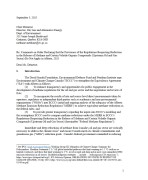Canada has missed every single GHG reduction target that has been set prior to its current 2030 target, and while a flurry of activity under the last government’s Pan Canadian Framework was a marked improvement over the prior decade of inaction, this country is still not on track to do its fair share toward limiting warming to 1.5°C for a safer world.
It is time to implement deeper, more structural change. To that end, Canada needs a legislated climate accountability framework. This report, jointly published by CANRac, Ecojustice, Environmental Defence, Équiterre, Pembina Institute and West Coast Environmental Law, sets out the key pillars of such a framework, modelled on international experience, but adapted to the Canadian context.
Executive Summary
Canada is warming at a rate roughly double that of the rest of the world. For northern parts of the country the warming trend is nearly three times the world rate. As global greenhouse gas emissions continue to increase, GHG concentrations will continue to rise, and Canada’s warming will continue its upward trend.
A business-as-usual trajectory will result in a fundamentally altered world, in which a child born today will experience a world more than four degrees warmer than the pre-industrial average, with climate change impacting human health from infancy and adolescence to adulthood and old age. The alternate path — which limits the global average temperature rise to “well below 2°C” – would transform the health of a child born today for the better, all the way through its life. The changes seen in this alternate pathway could result in cleaner air, safer cities, and more nutritious food, coupled with renewed investment in health systems and vital infrastructure.
Canada cannot expect others to do their part to reduce emissions unless it demonstrates mitigation action at home. To date, that action has been sorely inadequate. Canada has missed every single GHG reduction target that has been set prior to its current 2030 target, and while a flurry of activity under the last government’s Pan Canadian Framework (PCF) was a marked improvement over the prior decade of inaction, this country is still not on track for a 1.5°C world.
It is time to implement deeper, more structural change. To that end, Canada needs a legislated climate accountability framework. This report sets out the key pillars of such a framework, modelled on international experience, but adapted to the Canadian context.
Five pillars of Canadian Climate Accountability Act
Pillar 1: Long-term (2050 & 2030) GHG reduction targets that are ambitious and move Canada towards its fair contribution to a 1.5°C mitigation scenario.
Pillar 2: Five-year carbon budgets that cap total GHG emissions and fairly distribute emissions reductions across the country. Carbon budgets are the basis for mitigation planning.
Pillar 3: Five-year impact reports tabled before Parliament that assess the risks of current and predicted climate impacts in Canada. Impact reports are the basis for adaptation planning.
Pillar 4: Planning and reporting requirements to achieve carbon budgets and guide adaptation. Plans, progress reports on their implementation, and the government’s response to progress reports must be tabled before Parliament.
Pillar 5: Arm’s-length expert climate advisory committee to advise on long-term targets, five-year carbon budgets, climate impact reports and policy solutions, and independently monitor and report on implementation progress. The expert committee is central to the accountability framework and has a key role in each of the preceding pillars.
If implemented effectively, these pillars can transform how our country approaches climate action and redefine its ambition. In addition to Canada’s obligations to do its part – both internationally and to Canadians themselves – industry and businesses are asking for a clear climate framework to enhance certainty. A climate framework that charts a pathway to our long-term targets will promote steady action, avoid stop-start investment and ensure sufficient lead time for larger shifts in the economy – thereby providing more certainty for investors and stakeholders. A policy brief summary of this report is also available.







